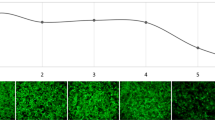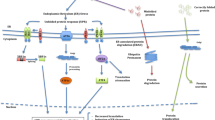Abstract
Alpha-1 antitrypsin (AAT) is a serum protease inhibitor, mainly expressed in and secreted from hepatocytes, important for regulating neutrophil elastase activity among other proteases. Various mutations in AAT cause alpha-1 antitrypsin deficiency (AATD), a rare hereditary disorder that results in liver disease due to accumulation of AAT aggregates and lung disease from excessive neutrophil elastase activity. PiZ transgenic mice contain the human AAT genomic region harboring the most common AATD mutation, the Glu342Lys (Z) point mutation. These mice effectively recapitulate the liver disease exhibited in AATD patients, including AAT protein aggregates, hepatocyte death, and eventual liver fibrosis. Previously, we demonstrated that modified antisense oligonucleotides (ASOs) can dramatically reduce Z-AAT RNA and protein levels in PiZ mice enabling inhibition, prevention, and reversal of the associated liver disease. Here, we describe in detail usage of AAT-ASOs to knock down Z-AAT in PiZ mice with a focus on preparation and in vivo delivery of ASOs, as well as detailed workflows pertaining to the analysis of Z-AAT mRNA, plasma protein, and soluble/insoluble liver protein levels following ASO administration.
Access this chapter
Tax calculation will be finalised at checkout
Purchases are for personal use only
Similar content being viewed by others
References
Janciauskiene SM, Bals R, Koczulla R, Vogelmeier C, Kohnlein T, Welte T (2011) The discovery of alpha1-antitrypsin and its role in health and disease. Respir Med 105(8):1129–1139. doi:10.1016/j.rmed.2011.02.002
Bals R (2010) Alpha-1-antitrypsin deficiency. Best Pract Res Clin Gastroenterol 24(5):629–633. doi:10.1016/j.bpg.2010.08.006
Ekeowa UI, Gooptu B, Belorgey D, Hagglof P, Karlsson-Li S, Miranda E, Perez J, MacLeod I, Kroger H, Marciniak SJ, Crowther DC, Lomas DA (2009) Alpha1-antitrypsin deficiency, chronic obstructive pulmonary disease and the serpinopathies. Clin Sci (Lond) 116(12):837–850. doi:10.1042/CS20080484
Fregonese L, Stolk J (2008) Hereditary alpha-1-antitrypsin deficiency and its clinical consequences. Orphanet J Rare Dis 3:16. doi:10.1186/1750-1172-3-16
Gooptu B, Ekeowa UI, Lomas DA (2009) Mechanisms of emphysema in alpha1-antitrypsin deficiency: molecular and cellular insights. Eur Respir J 34(2):475–488. doi:10.1183/09031936.00096508
Greene CM, Miller SD, Carroll T, McLean C, O'Mahony M, Lawless MW, O'Neill SJ, Taggart CC, McElvaney NG (2008) Alpha-1 antitrypsin deficiency: a conformational disease associated with lung and liver manifestations. J Inherit Metab Dis 31(1):21–34. doi:10.1007/s10545-007-0748-y
Hogarth DK, Rachelefsky G (2008) Screening and familial testing of patients for alpha 1-antitrypsin deficiency. Chest 133(4):981–988. doi:10.1378/chest.07-1001
Silverman EK, Sandhaus RA (2009) Clinical practice. Alpha1-antitrypsin deficiency. N Engl J Med 360(26):2749–2757. doi:10.1056/NEJMcp0900449
Teckman JH, Lindblad D (2006) Alpha-1-antitrypsin deficiency: diagnosis, pathophysiology, and management. Curr Gastroenterol Rep 8(1):14–20
Ekeowa UI, Freeke J, Miranda E, Gooptu B, Bush MF, Perez J, Teckman J, Robinson CV, Lomas DA (2010) Defining the mechanism of polymerization in the serpinopathies. Proc Natl Acad Sci U S A 107(40):17146–17151. doi:10.1073/pnas.1004785107
Lomas DA, Evans DL, Finch JT, Carrell RW (1992) The mechanism of Z alpha 1-antitrypsin accumulation in the liver. Nature 357(6379):605–607. doi:10.1038/357605a0
Fairbanks KD, Tavill AS (2008) Liver disease in alpha 1-antitrypsin deficiency: a review. Am J Gastroenterol 103(8):2136–2141.; quiz 2142. doi:10.1111/j.1572-0241.2008.01955.x
Nelson DR, Teckman J, Di Bisceglie AM, Brenner DA (2012) Diagnosis and management of patients with alpha1-antitrypsin (A1AT) deficiency. Clin Gastroenterol Hepatol 10(6):575–580. doi:10.1016/j.cgh.2011.12.028
Carlson JA, Rogers BB, Sifers RN, Finegold MJ, Clift SM, DeMayo FJ, Bullock DW, Woo SL (1989) Accumulation of PiZ alpha 1-antitrypsin causes liver damage in transgenic mice. J Clin Invest 83(4):1183–1190. doi:10.1172/JCI113999
Sifers RN, Carlson JA, Clift SM, DeMayo FJ, Bullock DW, Woo SL (1987) Tissue specific expression of the human alpha-1-antitrypsin gene in transgenic mice. Nucleic Acids Res 15(4):1459–1475
Hidvegi T, Ewing M, Hale P, Dippold C, Beckett C, Kemp C, Maurice N, Mukherjee A, Goldbach C, Watkins S, Michalopoulos G, Perlmutter DH (2010) An autophagy-enhancing drug promotes degradation of mutant alpha1-antitrypsin Z and reduces hepatic fibrosis. Science 329(5988):229–232. doi:10.1126/science.1190354
Mencin A, Seki E, Osawa Y, Kodama Y, De Minicis S, Knowles M, Brenner DA (2007) Alpha-1 antitrypsin Z protein (PiZ) increases hepatic fibrosis in a murine model of cholestasis. Hepatology 46(5):1443–1452. doi:10.1002/hep.21832
Perlmutter DH, Silverman GA (2011) Hepatic fibrosis and carcinogenesis in alpha1-antitrypsin deficiency: a prototype for chronic tissue damage in gain-of-function disorders. Cold Spring Harb Perspect Biol 3(3):a005801. doi:10.1101/cshperspect.a005801
Bennett CF, Swayze EE (2010) RNA targeting therapeutics: molecular mechanisms of antisense oligonucleotides as a therapeutic platform. Annu Rev Pharmacol Toxicol 50:259–293. doi:10.1146/annurev.pharmtox.010909.105654
Crooke ST (1999) Molecular mechanisms of action of antisense drugs. Biochim Biophys Acta 1489(1):31–44
Guo S, Booten SL, Aghajan M, Hung G, Zhao C, Blomenkamp K, Gattis D, Watt A, Freier SM, Teckman JH, McCaleb ML, Monia BP (2014) Antisense oligonucleotide treatment ameliorates alpha-1 antitrypsin-related liver disease in mice. J Clin Invest 124(1):251–261. doi:10.1172/JCI67968
Guo S, Booten SL, Watt A, Alvarado L, Freier SM, Teckman JH, McCaleb ML, Monia BP (2014) Using antisense technology to develop a novel therapy for alpha-1 antitrypsin deficient (AATD) liver disease and to model AATD lung disease. Rare Dis 2:e28511. doi:10.4161/rdis.28511
Zong X, Huang L, Tripathi V, Peralta R, Freier SM, Guo S, Prasanth KV (2015) Knockdown of nuclear-retained long noncoding RNAs using modified DNA antisense oligonucleotides. Methods Mol Biol 1262:321–331. doi:10.1007/978-1-4939-2253-6_20
Graham MJ, Lemonidis KM, Whipple CP, Subramaniam A, Monia BP, Crooke ST, Crooke RM (2007) Antisense inhibition of proprotein convertase subtilisin/kexin type 9 reduces serum LDL in hyperlipidemic mice. J Lipid Res 48(4):763–767. doi:10.1194/jlr.C600025-JLR200
Hung G, Xiao X, Peralta R, Bhattacharjee G, Murray S, Norris D, Guo S, Monia BP (2013) Characterization of target mRNA reduction through in situ RNA hybridization in multiple organ systems following systemic antisense treatment in animals. Nucleic Acid Ther 23(6):369–378. doi:10.1089/nat.2013.0443
Geary RS, Henry SP, Grillone LR (2002) Fomivirsen: clinical pharmacology and potential drug interactions. Clin Pharmacokinet 41(4):255–260. doi:10.2165/00003088-200241040-00002
Grillone LR, Lanz R (2001) Fomivirsen. Drugs Today (Barc) 37(4):245–255
Butler M, Hayes CS, Chappell A, Murray SF, Yaksh TL, Hua XY (2005) Spinal distribution and metabolism of 2′-O-(2-methoxyethyl)-modified oligonucleotides after intrathecal administration in rats. Neuroscience 131(3):705–715. doi:10.1016/j.neuroscience.2004.11.038
Passini MA, Bu J, Richards AM, Kinnecom C, Sardi SP, Stanek LM, Hua Y, Rigo F, Matson J, Hung G, Kaye EM, Shihabuddin LS, Krainer AR, Bennett CF, Cheng SH (2011) Antisense oligonucleotides delivered to the mouse CNS ameliorate symptoms of severe spinal muscular atrophy. Sci Transl Med 3(72):72ra18. doi:10.1126/scitranslmed.3001777
Templin MV, Levin AA, Graham MJ, Aberg PM, Axelsson BI, Butler M, Geary RS, Bennett CF (2000) Pharmacokinetic and toxicity profile of a phosphorothioate oligonucleotide following inhalation delivery to lung in mice. Antisense Nucleic Acid Drug Dev 10(5):359–368
An JK, Blomenkamp K, Lindblad D, Teckman JH (2005) Quantitative isolation of alphalAT mutant Z protein polymers from human and mouse livers and the effect of heat. Hepatology 41(1):160–167. doi:10.1002/hep.20508
Author information
Authors and Affiliations
Corresponding author
Editor information
Editors and Affiliations
Rights and permissions
Copyright information
© 2017 Springer Science+Business Media LLC
About this protocol
Cite this protocol
Aghajan, M., Guo, S., Monia, B.P. (2017). Knockdown of Z Mutant Alpha-1 Antitrypsin In Vivo Using Modified DNA Antisense Oligonucleotides. In: Borel, F., Mueller, C. (eds) Alpha-1 Antitrypsin Deficiency . Methods in Molecular Biology, vol 1639. Humana Press, New York, NY. https://doi.org/10.1007/978-1-4939-7163-3_12
Download citation
DOI: https://doi.org/10.1007/978-1-4939-7163-3_12
Published:
Publisher Name: Humana Press, New York, NY
Print ISBN: 978-1-4939-7161-9
Online ISBN: 978-1-4939-7163-3
eBook Packages: Springer Protocols




